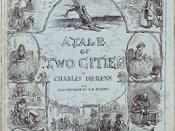Dickens' places a heavy load on opposite forces in A Tale of Two Cities. Such antitheses occur between polar characters and contrary settings, and they enhance the meaning of certain aspects of the novel to a great extent.
A great example of Dickens' use of antithesis can be found in the novel's two main female characters: Lucie Manette and Lady Defarge. Lucie embodies a loving and nurturing, good-natured person who is genuinely concerned with the interests of others as well as herself. The love that fuels her also initiates her father's spiritual transformation and renewal. At the other end of the spectrum, Lady Defarge is hateful and bloodthirsty. She serves as proof that bloodshed only leads to oppression and that violence is a never-ending cycle.
Both Paris and London, the cities of the title, have many similar features. Both are dealing with social problems and, both are being lead by monarchial governments, and both are dealing with or on the verge of a revolution.
Upon further examination however, the reader can see that these two urban settings are quite different. The Colonies' revolution against English imperialism was taking place 3000 miles away from England, where France's revolution would be waged door-to-door on domestic soil. Such a detail means a large difference in the social situation within a country. As French blood is drawn and pouring through the French gutters, social and economic issues compound themselves. In England, however, the citizens are granted a feeling of isolation from the gory conflict with their young colonies.
These facts contribute to what each city represents to the reader. London serves as somewhat of a safe haven for the characters. Life seems to be better there but they are continually drawn back to Paris by coincidental trouble. France was quite a dangerous region, as...


